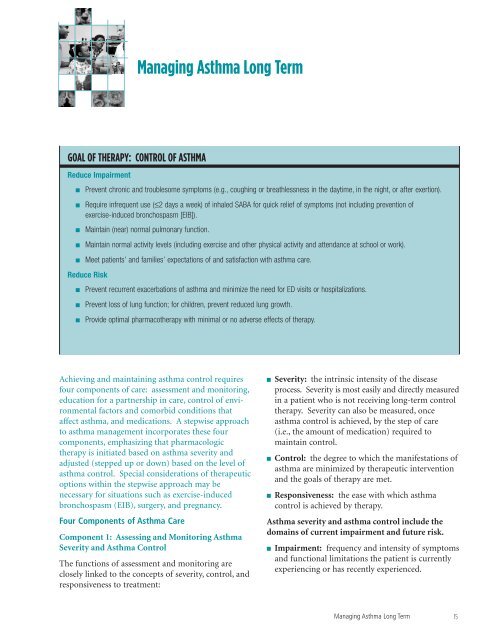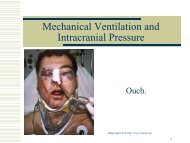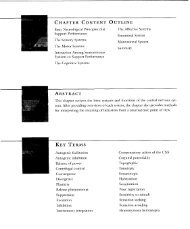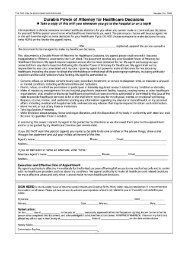Guidelines for the Diagnosis and Management of Asthma
Guidelines for the Diagnosis and Management of Asthma
Guidelines for the Diagnosis and Management of Asthma
Create successful ePaper yourself
Turn your PDF publications into a flip-book with our unique Google optimized e-Paper software.
Managing <strong>Asthma</strong> Long Term<br />
GOAL OF THERAPY: CONTROL OF ASTHMA<br />
Reduce Impairment<br />
■<br />
■<br />
■<br />
■<br />
■<br />
Prevent chronic <strong>and</strong> troublesome symptoms (e.g., coughing or breathlessness in <strong>the</strong> daytime, in <strong>the</strong> night, or after exertion).<br />
Require infrequent use (≤2 days a week) <strong>of</strong> inhaled SABA <strong>for</strong> quick relief <strong>of</strong> symptoms (not including prevention <strong>of</strong><br />
exercise-induced bronchospasm [EIB]).<br />
Maintain (near) normal pulmonary function.<br />
Maintain normal activity levels (including exercise <strong>and</strong> o<strong>the</strong>r physical activity <strong>and</strong> attendance at school or work).<br />
Meet patients’ <strong>and</strong> families’ expectations <strong>of</strong> <strong>and</strong> satisfaction with asthma care.<br />
Reduce Risk<br />
■<br />
■<br />
■<br />
Prevent recurrent exacerbations <strong>of</strong> asthma <strong>and</strong> minimize <strong>the</strong> need <strong>for</strong> ED visits or hospitalizations.<br />
Prevent loss <strong>of</strong> lung function; <strong>for</strong> children, prevent reduced lung growth.<br />
Provide optimal pharmaco<strong>the</strong>rapy with minimal or no adverse effects <strong>of</strong> <strong>the</strong>rapy.<br />
Achieving <strong>and</strong> maintaining asthma control requires<br />
four components <strong>of</strong> care: assessment <strong>and</strong> monitoring,<br />
education <strong>for</strong> a partnership in care, control <strong>of</strong> environmental<br />
factors <strong>and</strong> comorbid conditions that<br />
affect asthma, <strong>and</strong> medications. A stepwise approach<br />
to asthma management incorporates <strong>the</strong>se four<br />
components, emphasizing that pharmacologic<br />
<strong>the</strong>rapy is initiated based on asthma severity <strong>and</strong><br />
adjusted (stepped up or down) based on <strong>the</strong> level <strong>of</strong><br />
asthma control. Special considerations <strong>of</strong> <strong>the</strong>rapeutic<br />
options within <strong>the</strong> stepwise approach may be<br />
necessary <strong>for</strong> situations such as exercise-induced<br />
bronchospasm (EIB), surgery, <strong>and</strong> pregnancy.<br />
Four Components <strong>of</strong> <strong>Asthma</strong> Care<br />
Component 1: Assessing <strong>and</strong> Monitoring <strong>Asthma</strong><br />
Severity <strong>and</strong> <strong>Asthma</strong> Control<br />
The functions <strong>of</strong> assessment <strong>and</strong> monitoring are<br />
closely linked to <strong>the</strong> concepts <strong>of</strong> severity, control, <strong>and</strong><br />
responsiveness to treatment:<br />
■ Severity: <strong>the</strong> intrinsic intensity <strong>of</strong> <strong>the</strong> disease<br />
process. Severity is most easily <strong>and</strong> directly measured<br />
in a patient who is not receiving long-term control<br />
<strong>the</strong>rapy. Severity can also be measured, once<br />
asthma control is achieved, by <strong>the</strong> step <strong>of</strong> care<br />
(i.e., <strong>the</strong> amount <strong>of</strong> medication) required to<br />
maintain control.<br />
■ Control: <strong>the</strong> degree to which <strong>the</strong> manifestations <strong>of</strong><br />
asthma are minimized by <strong>the</strong>rapeutic intervention<br />
<strong>and</strong> <strong>the</strong> goals <strong>of</strong> <strong>the</strong>rapy are met.<br />
■ Responsiveness: <strong>the</strong> ease with which asthma<br />
control is achieved by <strong>the</strong>rapy.<br />
<strong>Asthma</strong> severity <strong>and</strong> asthma control include <strong>the</strong><br />
domains <strong>of</strong> current impairment <strong>and</strong> future risk.<br />
■ Impairment: frequency <strong>and</strong> intensity <strong>of</strong> symptoms<br />
<strong>and</strong> functional limitations <strong>the</strong> patient is currently<br />
experiencing or has recently experienced.<br />
Managing <strong>Asthma</strong> Long Term<br />
15





